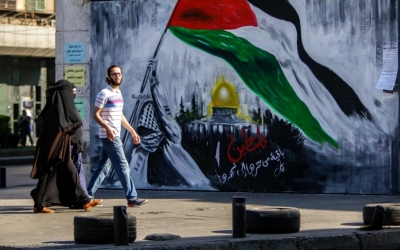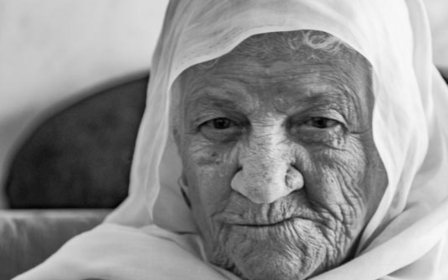Saving Lifta: Palestinians rally against latest threat to depopulated Jerusalem village

Small clusters of homes dot the hillside near Jerusalem, their sandy bricks standing out amid overgrown vegetation. While their former owners and their descendants continue to live close by, the buildings have remained uninhabited for decades - and now risk disappearing altogether.
Located northwest of Jerusalem, the village of Lifta has been a victim of expansion policies since the Nakba - or catastrophe - coinciding with the establishment of the state of Israel in 1948.
New MEE newsletter: Jerusalem Dispatch
Sign up to get the latest insights and analysis on Israel-Palestine, alongside Turkey Unpacked and other MEE newsletters
Although the area was declared a nature reserve by Israel in 2017, the Israeli Land Authority (ILA) announced on 9 May its intention to stage an open auction in July for private companies to bid on tenders for the construction of a new settlement on Lifta lands. The project is being advertised as planning for 250 housing units, hotels and commercial centres, all with beautiful hillside views only 10 kilometres away from Jerusalem.
But the slick modern project would entail the demolition of the remaining homes and landmarks of Lifta, effectively seeking to erase all traces of Palestinian identity and history in a site that was listed as endangered heritage in 2018 by the World Monuments Fund.
Zakaria Odeh, coordinator for the Civil Coalition for Palestinian Rights in Jerusalem, told Middle East Eye that the international community needed to intervene and pressure the Israeli government to end its policies of erasure of all reminders of the Palestinians who were forcibly expelled from their homes since 1948.
“We ask Unesco to intervene and to put a halt to the annihilation of the heritage and history of the village,” he said.
The latest Israeli plan once again highlights the long history of Lifta and the struggle of its former inhabitants, now refugees or internally displaced, to preserve its memory no matter what.
Decades of attempted erasure
Lifta was among the first of 38 villages in the district of Jerusalem to be forcibly depopulated in 1948, and dates back to the Canaanite era, when it was known by the name of Nephtoah. The village extends over an area of around 8,743 dunams (2,160 acres), part of which was occupied in 1948, with the remainder seized by Israel during the 1967 war.
Prior to the Nakba, some 3,000 people lived in 600 homes in Lifta. According to displaced residents of Lifta, only 73 houses still stand today - 56 of them quasi-intact, and 17 in ruins.
Among the landmarks still standing include a centuries-old mosque, the village cemetery, a water spring, and a primary school built in 1929, which today hosts Jewish-Israeli students. Over the years, a number of Israeli housing units and government buildings - including the Knesset, Israel’s parliament - and part of Hebrew University’s campus have been built on Lifta’s former farmlands.
Zakaria Odeh told MEE that the latest project by the ILA was nothing new, pointing out that the Israeli government had approved in 2006 a plan known as Plan No. 6036 for the establishment of a settlement known as Mei Neftoah on Lifta’s lands. The initial plans of the project were reportedly drawn up in the mid- to late 1990s, when the late Ariel Sharon was minister of infrastructure.
In 2009, the ILA put up Lifta lands for auction, in a plan that had set for all but 50 of the village’s buildings to be demolished.
However, former residents and descendants from Lifta submitted an objection in court in 2011 expressing their rejection of the plan.
By early 2012, the Israeli Court for Administrative Affairs issued a ruling cancelling the planned auction of Lifta lands. Now, a similar plan is being attempted once again by the ILA.
The curator of memories
Yaqoub Odeh, who was born in Lifta in 1940 and is now the head of the Lifta Cultural Heritage Protection Commission, is one of the most knowledgeable sources on the history of the village.
In his house in the Jerusalem neighbourhood of Shufat, Yaqoub Odeh told MEE of his childhood memories in the then-bustling village.
'Within an hour we went from being homeowners in our own village to seekers of refuge'
- Yaqoub Odeh, Nakba survivor
“When I left Lifta I was in second grade,” he said. “I still remember how I used to jump from one rock to another on my way home from school. I also remember how I used to fool around with the other children near the main water spring in the village.”
More than 70 years later, Yaqoub still remembers vividly the circumstances of his forced departure from Lifta. Zionist militias at the time had stationed themselves at the main entrances connecting Lifta to neighbouring villages and Jerusalem - prompting Palestinians to seek to transfer women and children out of the village to nearby caves, and then onward to the relative safety of neighbouring villages.
On that particular day in early March 1948, Yaqoub said his father had carried his little sister on his shoulders and held the hand of his brother, asking Yaqoub and his other sister to walk behind him until they reached the road connecting Jerusalem to Jaffa, where Zionist militia fighters fired a bullet that brushed his father’s traditional thobe tunic, before planting itself between his feet.
“A vehicle with children from four families was waiting for us,” Yaqoub said. “We stepped into the vehicle and became children of the fifth family.
“Within an hour we went from being homeowners in our own village to seekers of refuge, shelter and assistance in other people's houses. We left our houses with nothing except whatever garments we had on our backs, thinking that we would go back the following day. It has been 73 years since that day”.
Yaqoub is one of the former residents of Lifta lucky enough to be able to return to the village because of his East Jerusalem ID. While a number of villagers and their relatives live on the outskirts of Lifta, in neighbourhoods such as Wadi Joz and French Hill, others reside in the occupied West Bank - restricted from accessing Jerusalem - or emigrated abroad.
“I am keen to visit it on a regular basis in company with the women, children, men and elderly residents of the village, in an endeavour to preserve our narrative and our rights there,” he added. “Nothing equals the days when we visit our village, except the day of our actual return.”
When asked about the latest plan to build over what remains of Lifta, Yaqoub replied: “Memory and history are life itself, and I will allow no one under the sun to take away my memories, nor my heritage and that of my ancestors.”
“The tombs of our forefathers in the village stand as proof and witness to our historical Palestinian presence. We care about our cemetery and we clean it every time we visit the village,” he added.
Fawzia Obaidi, who was born in Lifta 79 years ago, immediately bursts into tears when the village is brought up.
“Lifta is my soulmate because it's my birthplace and the mother that failed to hug me,” she tells MEE from her home in East Jerusalem’s Ras al-Amoud neighbourhood. “I don’t miss any opportunity to visit Lifta and bring back with me some of its wild plants so I can plant them in the flowerpots I keep on my terrace - although they never smell as good as the original.”
Her eldest son Ibrahim goes to Lifta during the harvest season in order to bring his mother prickly figs, plums and almonds, hoping that the taste of these fruits may alleviate her nostalgia.
Despite the latest Israeli plans for Lifta, Obaidi remains adamant in her commitment to the village.
“We totally refuse the demolition of our houses and our heritage sites for the sake of building colonial settler units,” she said.
“They, meaning Israelis, deal with the village as if it were absentee property, but we are resilient and can’t wait to go back.
“The nostalgia of going back never leaves me.”
This article is available in French on Middle East Eye French edition.
Middle East Eye delivers independent and unrivalled coverage and analysis of the Middle East, North Africa and beyond. To learn more about republishing this content and the associated fees, please fill out this form. More about MEE can be found here.







